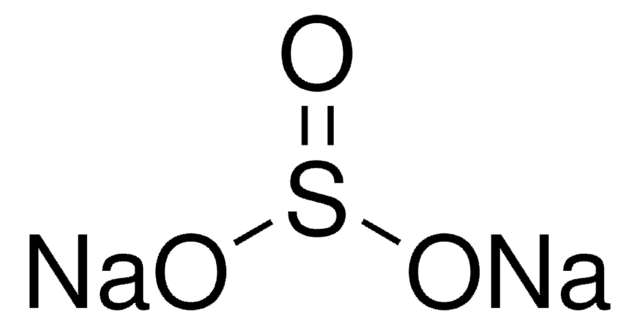S9000
Sodium metabisulfite
ReagentPlus®, ≥99%
Synonyme(s) :
Sodium disulfite, Sodium pyrosulfite
About This Item
Produits recommandés
Niveau de qualité
Gamme de produits
ReagentPlus®
Pureté
≥99%
Forme
powder
pH
4.5 (20 °C, 50 g/L)
Pf
>300 °C (lit.)
Chaîne SMILES
[Na+].[Na+].[O-]S(=O)S([O-])(=O)=O
InChI
1S/2Na.H2O5S2/c;;1-6(2)7(3,4)5/h;;(H,1,2)(H,3,4,5)/q2*+1;/p-2
Clé InChI
HRZFUMHJMZEROT-UHFFFAOYSA-L
Vous recherchez des produits similaires ? Visite Guide de comparaison des produits
Catégories apparentées
Application
- Sickle Erythrocyte Health Index: Discusses the use of sodium metabisulfite in stabilizing red blood cells for advanced computational analysis, crucial for the diagnosis and management of sickle cell disease (Ansong-Ansongton YON, Adamson TD, 2024).
- Chemical and Thermal Treatment for Drying Cassava Tubers: Explores sodium metabisulfite′s role in enhancing the drying process of cassava, focusing on optimizing microstructure and dehydration kinetics, which is vital for food preservation and processing (Nainggolan EA, Banout J, Urbanova K, 2023).
- Anionic Bio-flocculants from Sugarcane: Discusses the development of bio-flocculants using sodium metabisulfite for the purification of sucrose, demonstrating its potential in enhancing the sustainability of sugar processing industries (Leão S, Magalhães S, et al., 2023).
Autres remarques
Informations légales
Mention d'avertissement
Danger
Mentions de danger
Conseils de prudence
Classification des risques
Acute Tox. 4 Oral - Eye Dam. 1
Risques supp
Code de la classe de stockage
11 - Combustible Solids
Classe de danger pour l'eau (WGK)
WGK 3
Point d'éclair (°F)
Not applicable
Point d'éclair (°C)
Not applicable
Certificats d'analyse (COA)
Recherchez un Certificats d'analyse (COA) en saisissant le numéro de lot du produit. Les numéros de lot figurent sur l'étiquette du produit après les mots "Lot" ou "Batch".
Déjà en possession de ce produit ?
Retrouvez la documentation relative aux produits que vous avez récemment achetés dans la Bibliothèque de documents.
Les clients ont également consulté
Notre équipe de scientifiques dispose d'une expérience dans tous les secteurs de la recherche, notamment en sciences de la vie, science des matériaux, synthèse chimique, chromatographie, analyse et dans de nombreux autres domaines..
Contacter notre Service technique











